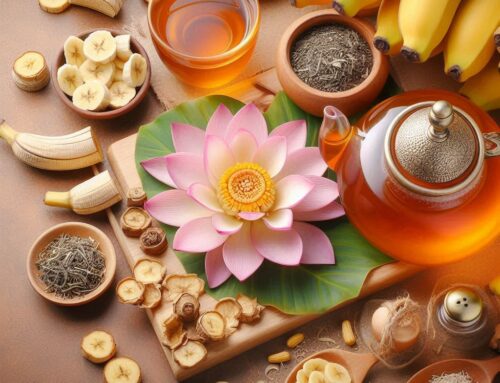
Introduction: Understanding Banana Blossom and Its Nutritional Profile
Banana blossom, also known as banana flower, is a nutrient-rich food that has been gaining attention for its impressive nutritional profile and health benefits. This lesser-known part of the banana plant is often used in Southeast Asian cuisines and is celebrated not only for its unique taste but also for its nutritional value.
What exactly is a banana blossom? It is the large, purple-skinned flower that grows at the end of a banana cluster. Inside, it contains small florets that are edible and can be incorporated into various dishes. Rich in vitamins and minerals, banana blossoms are an excellent source of dietary fiber, potassium, calcium, magnesium, iron, copper, and essential fatty acids.
One of the notable benefits of consuming banana blossoms lies in their potential to support breastfeeding mothers. These flowers are considered nutrient-rich foods for breastfeeding due to their ability to enhance milk production and provide essential nutrients needed during lactation.
In addition to supporting lactation, banana blossoms offer other health advantages such as improving digestion due to their high fiber content and promoting heart health by helping manage cholesterol levels. As more people seek out diverse sources of nutrition beyond traditional fruits and vegetables, incorporating banana blossoms into your diet could be a delightful way to enjoy both flavor and health benefits.
Promoting Lactation: How Banana Blossom Enhances Milk Production
Banana blossom, often overlooked in the culinary world, is gaining recognition as a powerful ally in promoting lactation. Known for its rich nutritional profile, this flowering part of the banana plant is packed with essential vitamins and minerals that support breastfeeding mothers. As a natural lactation booster, banana blossom plays a significant role in increasing breast milk supply naturally.
Incorporating banana blossom into your breastfeeding diet can be an effective way to enhance milk production. It contains high levels of iron, calcium, and fiber—nutrients crucial for nursing mothers. Iron helps combat postpartum anemia, while calcium supports bone health for both mother and baby. The fiber content aids digestion and overall well-being.
To include this superfood in your diet, consider adding it to soups or salads for a nutritious boost. Its mild flavor makes it versatile enough to blend seamlessly into various dishes without overpowering other ingredients. By embracing such lactation foods as banana blossom, mothers can find an accessible and natural method to support their breastfeeding journey effectively.
Remember that while dietary changes can contribute positively to milk supply, they should complement other healthy lifestyle practices recommended by healthcare professionals. Always consult with a healthcare provider before making significant alterations to your diet during breastfeeding.
Nutritional Benefits: Key Vitamins and Minerals in Banana Blossom for Mom and Baby
Banana blossom, often overlooked in Western diets, is a nutritional powerhouse that can be particularly beneficial for nursing mothers and their babies. Packed with essential vitamins and minerals, this unique flower offers a range of health benefits that support both maternal health and infant development.
One of the standout features of banana blossom is its rich content of vitamins such as Vitamin C and Vitamin E. These antioxidants play a critical role in protecting cells from damage, boosting the immune system, and promoting healthy skin. For nursing mothers, maintaining adequate levels of these vitamins is crucial as they help in tissue repair and overall vitality during the demanding breastfeeding period.
In addition to its vitamin content, banana blossom is also mineral-rich, making it an excellent dietary choice for those seeking to enhance their nutritional intake during breastfeeding. It contains significant amounts of iron—essential for preventing anemia—and magnesium, which supports muscle function and helps reduce stress levels. Both minerals are vital for new moms who need to recover postpartum while managing the physical demands of caring for a newborn.
Furthermore, banana blossoms are high in dietary fiber, aiding digestion and helping maintain stable blood sugar levels. This can be particularly beneficial for nursing mothers who require sustained energy throughout the day.
Incorporating banana blossom into your diet during breastfeeding not only enriches your meals but also ensures that you are providing your baby with nutrient-dense breast milk. As part of a balanced diet featuring other mineral-rich foods for nursing moms, banana blossoms can contribute significantly to both maternal health and child development.
Incorporating Banana Blossom into Your Diet: Easy Recipes and Preparation Tips
Incorporating banana blossom into your diet can be a delightful and nutritious experience, especially for those looking to explore new ingredients. Banana blossoms, also known as banana flowers, are not only versatile but also packed with health benefits. They are particularly beneficial for lactating mothers due to their rich nutrient profile.
To start cooking with banana blossoms, it’s important to know how to prepare them properly. Begin by peeling off the outer layers until you reach the tender inner core. The florets inside can be used in various dishes and should be soaked in water with a bit of lemon juice or vinegar to prevent discoloration.
One popular way to enjoy banana blossoms is by making a savory stir-fry. Simply sauté onions, garlic, and your choice of vegetables in olive oil before adding sliced banana blossoms. Season with soy sauce and a dash of pepper for a quick and healthy meal.
For those looking for recipes with banana blossoms that offer more variety, consider trying them in salads or curries. A simple salad can be made by combining shredded banana blossom with grated coconut, chopped herbs like cilantro or mint, lime juice, and roasted peanuts for added crunch.
Incorporating these recipes into your meals not only diversifies your diet but also provides essential nutrients that support overall health. With these easy preparation tips and creative ideas, cooking with banana blossoms becomes an enjoyable culinary adventure that anyone can master.
Potential Health Benefits Beyond Lactation Support
Banana blossoms, often overshadowed by the fruit they accompany, are emerging as a nutritional powerhouse with potential health benefits extending far beyond traditional lactation support. While commonly recognized for their role in boosting milk supply among nursing mothers, these blossoms offer a wealth of advantages that can benefit anyone seeking to enhance their overall health.
One of the standout features of banana blossoms is their immune-boosting properties. Rich in essential vitamins and antioxidants, they help strengthen the body’s defense mechanisms against infections and diseases. Consuming banana blossoms can provide a natural way to bolster your immune system, making them a valuable addition to your diet during flu season or any time you feel your body needs an extra line of defense.
In addition to supporting immunity, banana flowers are celebrated for promoting digestive health. They contain dietary fiber that aids in digestion and helps maintain regular bowel movements, reducing the risk of constipation. The consumption of banana blossoms can also support gut health by fostering a balanced microbiome environment due to their prebiotic content.
For those recovering postpartum, incorporating banana blossom into meals can be particularly beneficial. As part of postpartum recovery foods, these flowers offer not only nutritional value but also anti-inflammatory properties that may assist in healing after childbirth. Their nutrient density supports overall recovery by replenishing vital nutrients lost during pregnancy and delivery.
In summary, while traditionally associated with lactation support, banana blossoms present an array of potential health benefits worth exploring for anyone interested in enhancing immune function and digestive wellness or seeking supportive nutrition during postpartum recovery.
Cautions and Considerations When Using Banana Blossom as a Dietary Supplement During Breastfeeding
When considering dietary supplements during breastfeeding, it’s crucial to prioritize both the mother’s and baby’s health. Banana blossom, also known as banana flower, has gained attention for its nutritional benefits and potential to enhance milk production. However, understanding the safety of eating banana flower while nursing is essential.
First and foremost, consult with a healthcare provider before incorporating banana blossom into your diet. This ensures that any dietary changes align with your specific health needs and those of your baby. While banana blossom is generally considered safe for consumption, individual reactions can vary, particularly concerning potential allergies.
It’s important to note that some individuals may experience allergic reactions to banana blossoms. Symptoms can include itching, swelling, or digestive discomfort. If you have a known allergy to bananas or similar fruits, exercise caution when introducing banana blossom into your diet.
In addition to potential allergies, consider any existing dietary restrictions during breastfeeding. A balanced diet rich in nutrients supports both maternal health and optimal milk production. Thus, while exploring new supplements like banana blossom can be beneficial, they should complement rather than replace other essential food groups.
In summary, while the inclusion of banana blossom in a breastfeeding diet might offer certain advantages, it requires careful consideration of safety factors and potential allergies. Always seek professional guidance to ensure that any dietary changes support both you and your baby’s well-being effectively.






